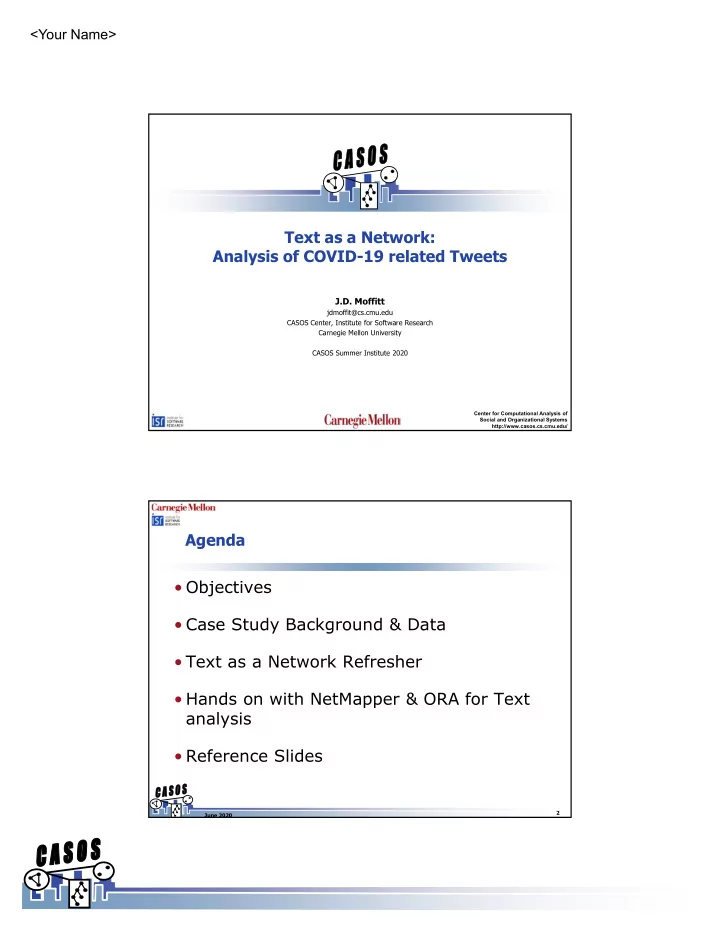

<Your Name> Text as a Network: Analysis of COVID-19 related Tweets J.D. Moffitt jdmoffit@cs.cmu.edu CASOS Center, Institute for Software Research Carnegie Mellon University CASOS Summer Institute 2020 Center for Computational Analysis of Social and Organizational Systems http://www.casos.cs.cmu.edu/ Agenda • Objectives • Case Study Background & Data • Text as a Network Refresher • Hands on with NetMapper & ORA for Text analysis • Reference Slides 2 June 2020 1
<Your Name> Objectives of this case study • In the context of the COVID-19 pandemic: – How can we use Dynamic Network Analysis tools to examine the Twitter conversation around COVID-19 as a bioweapon? – How can we discover emerging topics, individuals, groups, or organizations through twitter discourse? 3 June 2020 Known COVID19 Mis-/Dis-Information Campaigns 1. Stories relating inaccurate information about cures or preventative measures 2. Stories relating inaccurate information about the nature of the virus 3. Stories relating inaccurate information that are conspiracy stories 4 June 2020 2
<Your Name> Data: COVID19 Related Tweets (Bioweapon) Raw Data: • Tweets collected from global Twitter stream based on keywords: NCoV2019 coronaravirus covid19 NCoV covid-19 wuhanvirus 2019nCoV wuhan virus coronavirus covid 19 • Using regular expressions, further filtered tweets for only those containing the word bioweapon bioweapon bioweapons Lab bat bio-weapon 5G • Resulting in: – ~97,000 tweets from 16-29 February 2020 – ~200,000 tweets from 01-31 March 2020 Data Processing: Conducted feature Parsed tweet Filtered for Extracted tweet engineering for objects from 150 tweets in text for content network/key entity to 11 attributes English analysis Analysis 5 June 2020 Method / Analysis Network Metric Analysis: • Nodes/links/density/etc. • Composition of nodes (who is in convo) Network Construction: – Bots / Countries / Agent type • Create edge lists from tweets • Re-tweet Network • Reply Network • Mention Network Key Entity Analysis: • Identify Who is important – Dynamically Changes over time – Statically In a given period • Identify/Analyze what the important entities are saying 6 June 2020 3
<Your Name> Example Re-Tweet Network (23 FEB 2020) 7 June 2020 Example Re-tweet Key Entity Text (FEB 2020) 8 June 2020 4
<Your Name> Why Text? • Text is a cheap easy way to store large volumes of information – Books – Documents (legal, annual reports, transcripts, mission statements) – News – Blogs – Social Media • Information can be extracted from Text: – Content Analysis (word counts, parts of speech, concepts) – Key Entity Analysis (Find people, Organizations, Locations) – Topic Analysis (#’s, hot topics, themes, groups of topics) – Semantic Network Analysis (mental models of text usage) – Meta-Network Analysis – Sentiment Analysis 9 June 2020 Text in Network Terms • Nodes J.D. – Concepts Drinks – Words Bourbon PhD – Phrases Student • Link / Edges – Link between two+ concepts – i.e. a statement Studies Carnegie • Network Mellon Univ – Union of all statements in a text – A Map • Meta-network J.D. Societal – Map + Taxonomy Computing PhD Bourbon Student Agent Organization Carnegie Study Task Mellon Univ Resource Location PGH 10 June 2020 5
<Your Name> Semantic Network vs Meta-Network J.D. J.D. Bourbon Societal Computing Societal PhD Drinks PhD Computing Student Student Bourbon Study Carnegie Studies Mellon Carnegie Univ PGH Mellon Univ Agent Resource PGH Organization Location Task • Semantic Network: • Meta-Network: – Cross-classify nodes in semantic network into – One mode network (concepts & categories connections) – Requires Mapping of Words to Categories (explicit – Cognitive / Mental Model that can: or algorithms) 1. Represent the author’s reality – Allows Analyst to: 2. Represent the author’s 1. Who is linked to orgs, resources, tasks 2. What resources or knowledge are needed for knowledge & Information on a what task topic 3. Agent characteristics 4. Types of orgs, locations, etc. 11 June 2020 Turning Text into Networks Tip: Analyst can refine thesauri and delete lists after observing NetMapper outputs and reprocess text with new inputs • .XML • Raw Text File • CSV • JSON (tweets) • CSV Preprocess NetMapper ORA (Choose your favorite tool) • Text • Thesauri • Analysis – Source – Link relevant concepts – Reduction – Ontology cross-classification • Attribute Addition – Normalization – Reduce noise by combining common spellings, mis-spellings • Links • Geo-location – Built-in or User-defined – Domain / subject expertise – Develop initial scheme for how concepts are linked • Delete Lists • Membership and – Can adjust pre- & post-processing belief inference – Remove words that do not contribute to analysis – Built-in or User-defined 12 June 2020 6
<Your Name> Hands on Exercise 13 June 2020 Hands on Exercise 1. Process raw .txt file in NetMapper 2. Refine Thesaurus and Delete Lists 3. Create Semantic and Meta-Networks by day for tweets from (14-29 FEB 2020) 4. Load Networks into ORA for Analysis 5. Refined Thesaurus and Delete Lists in ORA 6. Explore ORA Reports that Aide in Text Analysis 14 June 2020 7
<Your Name> Reference Slides 15 June 2020 Reference Slide: NetMapper Add User Defined Thesaurus & DL. Add text for Analysis. Can handle single or multiple documents. If you have a user-defined thesaurus make sure you check this box. Adjust other settings as needed. 16 June 2020 8
<Your Name> Reference Slide: NetMapper Choices made here depend on type and size of document. For larger documents it may be prudent to search by sentence, and for smaller text by word. Analysist should experiment/refine to find best settings for their text. • Search Window Type: Sentence vs Word • Search Window Width: 1 to N • Sentiment Window Width: 1 to N 17 June 2020 Reference Slide: ORA Edit Nodes To Delete or Merge Nodes: 1. Select node(s) of interest 2. Right Click 3. Choose Appropriate Action 18 June 2020 9
<Your Name> Reference Slide: ORA Reports Used Semantic Network Report Topic Analysis Report Change in Key Entities Report 19 June 2020 10
Recommend
More recommend